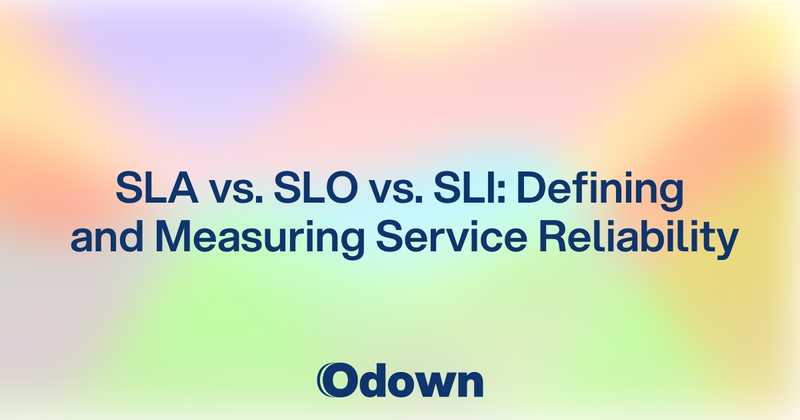SLA vs. SLO vs. SLI: Defining and Measuring Service Reliability
In today's digital landscape, reliability isn't just a technical goal—it's a business imperative. Organizations increasingly depend on consistent, measurable service quality to meet customer expectations and business objectives. The terminology around service reliability—SLAs, SLOs, and SLIs—provides a framework for defining, measuring, and improving service quality, but these terms are often confused or used interchangeably.
Understanding the distinctions between Service Level Agreements (SLAs), Service Level Objectives (SLOs), and Service Level Indicators (SLIs) is essential for teams tasked with building and maintaining reliable systems. This guide clarifies these concepts and provides practical implementation strategies to enhance your service reliability program.
Understanding Service Level Terminology
Before implementing a service reliability framework, it's important to understand what each term means and how they relate to one another:
Service Level Agreement (SLA)
An SLA is a formal contract between a service provider and its customers that defines the expected level of service:
Key Characteristics:
- Legally binding document with financial or contractual consequences
- Typically expressed in terms of uptime percentages (e.g., 99.9% availability)
- Often includes remedies or penalties for failing to meet agreed-upon levels
- Established by business and legal teams, not just engineering
Example SLA Terms:
- "The service will be available 99.95% of the time, measured monthly."
- "API requests will receive a response within 500ms for 99.9% of requests."
- "In the event of failure to meet these commitments, service credits of 10% will be applied."
Common SLA Components:
- Scope of services covered
- Performance metrics and thresholds
- Measurement methodology
- Exclusions and caveats (planned maintenance, force majeure)
- Reporting frequency and format
- Remediation procedures and penalties
Service Level Objective (SLO)
An SLO is an internal target or goal for service performance and reliability:
Key Characteristics:
- Internal commitment, not a legal contract
- More stringent than SLAs to provide a safety margin
- Used to guide engineering decisions and prioritization
- Helps teams manage their "error budget"
Example SLOs:
- "Our API will have a 99.99% success rate, measured as valid HTTP responses over 28 days."
- "Homepage load time will be under 2 seconds for 99.5% of requests."
- "Database query latency will be under 100ms for 99.9% of queries."
Relationship to SLAs:
- SLOs are typically stricter than SLAs
- If your SLA promises 99.9% availability, your SLO might target 99.95%
- This buffer allows teams to detect and address issues before they impact SLAs
Service Level Indicator (SLI)
An SLI is a specific metric that measures compliance with an SLO:
Key Characteristics:
- Quantitative measure of service level
- Usually expressed as a ratio or percentage over time
- Should reflect actual user experience
- Must be measurable and actionable
Common SLI Types:
- Availability: Percentage of successful requests
SLI = Successful Requests / Total Requests
- Latency: Percentage of requests faster than threshold
SLI = Requests < Threshold / Total Requests
- Throughput: Requests processed within time period
SLI = Requests Processed / Time Period
- Error Rate: Percentage of error-free operations
SLI = Error-Free Operations / Total Operations
- Saturation: Resource utilization below critical threshold
SLI = Time Below Threshold / Total Time
As highlighted in our recent article on the future of website reliability engineering, these metrics are becoming increasingly sophisticated as organizations adopt AI-driven predictive monitoring approaches.
Setting Appropriate Service Level Objectives
Creating effective SLOs requires balancing user expectations with technical feasibility and business priorities:
Calculating Meaningful Availability Metrics
Availability is often expressed as a percentage (e.g., 99.9%, also known as "three nines"), but calculating this metric effectively requires careful consideration:
Measurement Approaches:
- Time-based Availability: Percentage of time a service is operational
Availability = Uptime / (Uptime + Downtime)
- Request-based Availability: Percentage of successful requests
Availability = Successful Requests / Total Requests
Availability Table and Business Impact:
| Availability % | Downtime per Year | Downtime per Month | Downtime per Week |
|---|---|---|---|
| 99% ("two nines") | 3.65 days | 7.31 hours | 1.68 hours |
| 99.9% ("three nines") | 8.77 hours | 43.83 minutes | 10.08 minutes |
| 99.95% | 4.38 hours | 21.92 minutes | 5.04 minutes |
| 99.99% ("four nines") | 52.60 minutes | 4.38 minutes | 1.01 minutes |
| 99.999% ("five nines") | 5.26 minutes | 26.30 seconds | 6.05 seconds |
Selecting Appropriate Time Windows
-
Rolling Windows: Measure over last N days (e.g., 28 days)
- Advantage: Provides current status without waiting for period end
- Challenge: More complex to implement
-
Calendar Windows: Measure over fixed periods (e.g., monthly)
- Advantage: Simpler to understand and communicate
- Challenge: May delay detection of compliance issues
Implementation Tips:
- Start with lower SLO targets and increase over time
- Use different SLOs for different service tiers or components
- Consider user impact rather than just technical metrics
- Account for planned maintenance in your calculations
Establishing Error Budgets
Error budgets transform reliability from a binary state (reliable/unreliable) to a manageable resource:
What is an Error Budget?
An error budget is the allowed amount of unreliability based on your SLO. For example, with a 99.9% availability SLO, your error budget is 0.1% (or 43.83 minutes per month).
Error Budget Calculation:
Error Budget = 100% - SLO percentage
Using Error Budgets
Release Management:
- If error budget is healthy: Deploy new features
- If error budget is depleted: Focus on reliability improvements
Risk Tolerance:
- Quantify acceptable risk for business decisions
- Balance innovation velocity with stability
Team Alignment:
- Provide objective data for engineering vs. product discussions
- Create shared understanding of reliability priorities
Error Budget Policies
service: payment-api
slo: 99.95%
error_budget: 0.05%
measurement_window: 30 days
policy_triggers:
- condition: "budget_spent > 50%"
actions:
- "alert_team"
- "review_recent _deployments"
- condition: "budget_spent > 75%"
actions:
- "pause_non_ critical_deployments"
- "escalate_to_ engineering_management"
- condition: "budget_spent > 100%"
actions:
- "freeze_all_deployments"
- "focus_exclusively_ on_reliability"
- "post_incident_ review_required"
Creating SLA Reports for Stakeholders
Effective communication about service levels builds trust with stakeholders:
Report Audiences and Requirements:
Executive Leadership:
- High-level SLA compliance status
- Business impact of reliability issues
- Trend analysis and forecasting
Customers:
- Transparent SLA performance data
- Incident summaries with root causes
- Remediation steps and improvements
Engineering Teams:
- Detailed SLI metrics
- Error budget status
- Technical performance indicators
Sample SLA Report Structure:
Monthly SLA Report: June 2025
Executive Summary
- Overall SLA compliance: 99.98% (target: 99.95%)
- Error budget remaining: 78%
- Notable incidents: 1 (June 15, 12:34–13:02 UTC)
- Trend: Improving (+0.02% from May)
Service Performance
| Service | SLA Target | Actual Performance | Status |
|---|---|---|---|
| API Gateway | 99.95% | 99.99% | ✅ |
| Database | 99.9% | 99.95% | ✅ |
| Authentication | 99.99% | 99.97% | ❌ |
Incident Analysis
- Authentication service degradation (June 15)
- Root cause: Database connection pool exhaustion
- Impact: 4.25% of login attempts failed over 28 minutes
- Resolution: Increased connection pool size, added monitoring
- Future prevention: Implementing dynamic pool sizing
Upcoming Reliability Improvements
- Enhanced regional failover testing
- Database read replica deployment
- API throttling refinement
Implementing SLI Monitoring with Odown
Translating SLOs into actionable monitoring requires proper implementation:
Setting Up Basic SLI Monitoring
Start by monitoring the most critical user journeys:
- name: "API Availability SLI"
endpoint: "https://api.example.com /health"
method: "GET"
interval: "1m"
locations:
- "us-east"
- "europe-west"
- "asia-east"
assertions:
- type: "status_code"
value: 200
- type: "response_time"
operator: "<"
value: "300ms"
sli:
type: "availability"
window: "28d"
target: 99.95%
Implementation Steps
-
Identify Critical User Journeys:
- Login/authentication
- Core business transactions
- Data retrieval operations
- Payment processing
-
Define SLIs for Each Journey:
- Availability metrics
- Performance thresholds
- Error rates
- Data quality indicators
-
Configure Monitoring Endpoints:
- HTTP/API health checks
- Synthetic transactions
- Backend service metrics
- User experience indicators
-
Set Up Alert Thresholds:
- Warning thresholds at 70% of error budget
- Critical thresholds at 90% of error budget
- Burn rate alerts for rapid degradation
Advanced SLI Implementation Techniques
Enhance your SLI monitoring with these advanced techniques:
Multi-Step Transaction Monitoring
name: "Checkout Process SLI"
steps:
- name: "Add to Cart"
url: "https://shop.example.com/ cart/add"
method: "POST"
body: {"product_id": "12345", "quantity": 1}
assertions:
- type: "status_code"
value: 200
- type: "response_time"
operator: "<"
value: "500ms"
- name: "Checkout"
url: "https://shop.example.com/ checkout"
method: "GET"
assertions:
- type: "status_code"
value: 200
- type: "content"
contains: "Payment Information"
- name: "Complete Payment"
url: "https://shop.example.com/ payment/process"
method: "POST"
body: {"payment_method": "credit_card", "token": "{{token}}"}
assertions:
- type: "status_code"
value: 200
- type: "response_time"
operator: "<"
value: "1s"
sli:
type: "transaction_success"
window: "7d"
target: 99.5%
Custom SLI Metrics
function calculateDataFreshnessSLI (monitorResults) {
let totalChecks = monitorResults.length;
let freshnessViolations = 0;
monitorResults.forEach(result => {
const dataTimestamp = new Date (result.response. data.updated_at);
const checkTime = new Date (result.timestamp);
const stalenessMinutes = (checkTime - dataTimestamp) / (1000 * 60);
if (stalenessMinutes > 15) {
freshnessViolations++;
}
});
return ((totalChecks - freshnessViolations) / totalChecks) * 100;
}
Regional SLI Variations
base_slo: 99.9%
regional_adjustments:
- region: "asia-east"
slo: 99.5%
- region: "us-east"
slo: 99.95%
compliance_calculation: "per_region"
Integrating SLIs with Business Metrics
Connect technical metrics to business outcomes:
Business Impact Mapping
Revenue Impact:
- E-commerce: Cart abandonment during slowdowns
- SaaS: Subscription cancellations after outages
- Media: Ad impression loss during unavailability
User Experience Correlation:
- Session duration vs. system performance
- Feature usage vs. availability
- User retention vs. reliability metrics
Implementation Example
{
"dashboard": "Reliability Business Impact",
"panels": [
{
"title": "Checkout SLI vs. Conversion Rate",
"type": "combined",
"metrics": [
{
"name": "Checkout SLI",
"query": "sli:checkout_success",
"yAxis": "left"
},
{
"name": "Conversion Rate",
"query": "business: conversion_percentage",
"yAxis": "right"
}
],
"annotations": [
{
"name": "SLO Threshold",
"value": 99.5,
"color": "red"
},
{
"name": "Deployments",
"source": "deployment_events"
}
]
}
]
}
Case Studies: SLO Implementation in Practice
E-Commerce Platform Reliability
An online retailer implemented tiered SLOs based on customer journey importance:
SLO Hierarchy:
- Critical Path (Payment, Checkout): 99.99% availability
- Product Browsing: 99.95% availability
- Account Management: 99.9% availability
- Recommendation Engine: 99.5% availability
Results:
- 30% reduction in checkout abandonment
- Improved engineering focus on highest-value components
- Better capacity planning for peak shopping seasons
Financial Services API Reliability
A payment processor implemented comprehensive SLIs across their API platform:
Key SLIs:
- Transaction success rate: 99.999%
- API response time (95th percentile): <300ms
- Token validation availability: 99.995%
- Data consistency (failed reconciliations): <0.001%
Implementation Strategy:
- Multi-region monitoring with geo-specific SLOs
- Synthetic transaction testing every minute
- Graduated alert thresholds with automated mitigation
- Daily SLI reviews with cross-functional teams
Best Practices and Common Pitfalls
Reliability Program Success Factors
Keys to Success:
- Start with user-focused metrics
- Implement gradually, beginning with critical services
- Secure executive sponsorship and understanding
- Provide clear documentation and education
- Review and refine SLOs quarterly
Common Pitfalls to Avoid
- Setting unrealistic SLOs (e.g., 100% availability)
- Creating too many SLOs without prioritization
- Focusing on technical metrics instead of user experience
- Ignoring cultural aspects of reliability engineering
- Using SLAs and SLOs interchangeably
SLO Template Library
Web Application Template
user_journeys:
- name: "Homepage Load"
sli_type: "latency"
threshold: "2s"
target: 99.5%
measurement: "95th_percentile"
- name: "User Login"
sli_type: "availability"
threshold: "success"
target: 99.9%
- name: "Search Functionality"
sli_type: "latency"
threshold: "1s"
target: 99%
measurement: "90th_percentile"
API Service Template
endpoints:
- path: "/api/v1/*"
slis:
- type: "availability"
target: 99.95%
- type: "latency"
threshold: "300ms"
target: 99%
measurement: "95th_percentile"
- type: "saturation"
resource: "database_connections"
threshold: "80%"
target: 99.9%
Mobile App Backend Template
regions:
- name: "north-america"
slo_adjustment: +0.05%
- name: "europe"
slo_adjustment: +0.05%
- name: "asia"
slo_adjustment: -0.1%
operations:
- name: "Data Sync"
sli_type: "success_rate"
target: 99.5%
- name: "Push Notification Delivery"
sli_type: "latency"
threshold: "5s"
target: 99%
- name: "Authentication"
sli_type: "availability"
target: 99.9%
Conclusion
Implementing a coherent service level framework is a journey, not a destination. By clearly differentiating between SLAs (legal agreements), SLOs (engineering targets), and SLIs (measured metrics), organizations can build a reliability program that balances innovation with stability.
Remember that the ultimate goal isn't perfect uptime, but rather the optimal balance of reliability, cost, and innovation velocity. Start with user-focused metrics, implement gradually, and continuously refine your approach based on real-world results.
By establishing clear service level objectives and measuring the right indicators, you can make data-driven decisions about reliability investments, communicate effectively with stakeholders, and deliver the consistent service quality that modern users expect.



